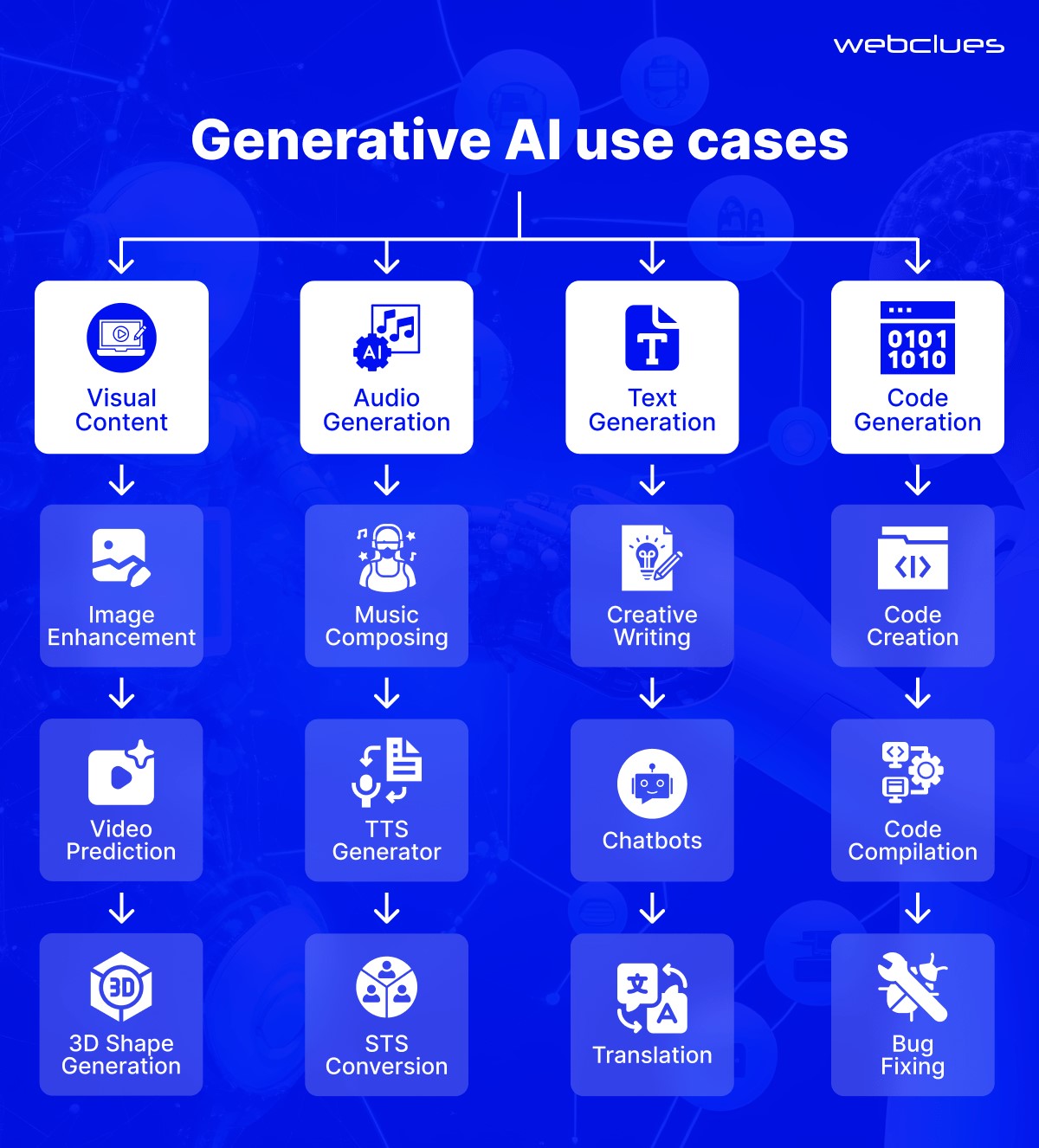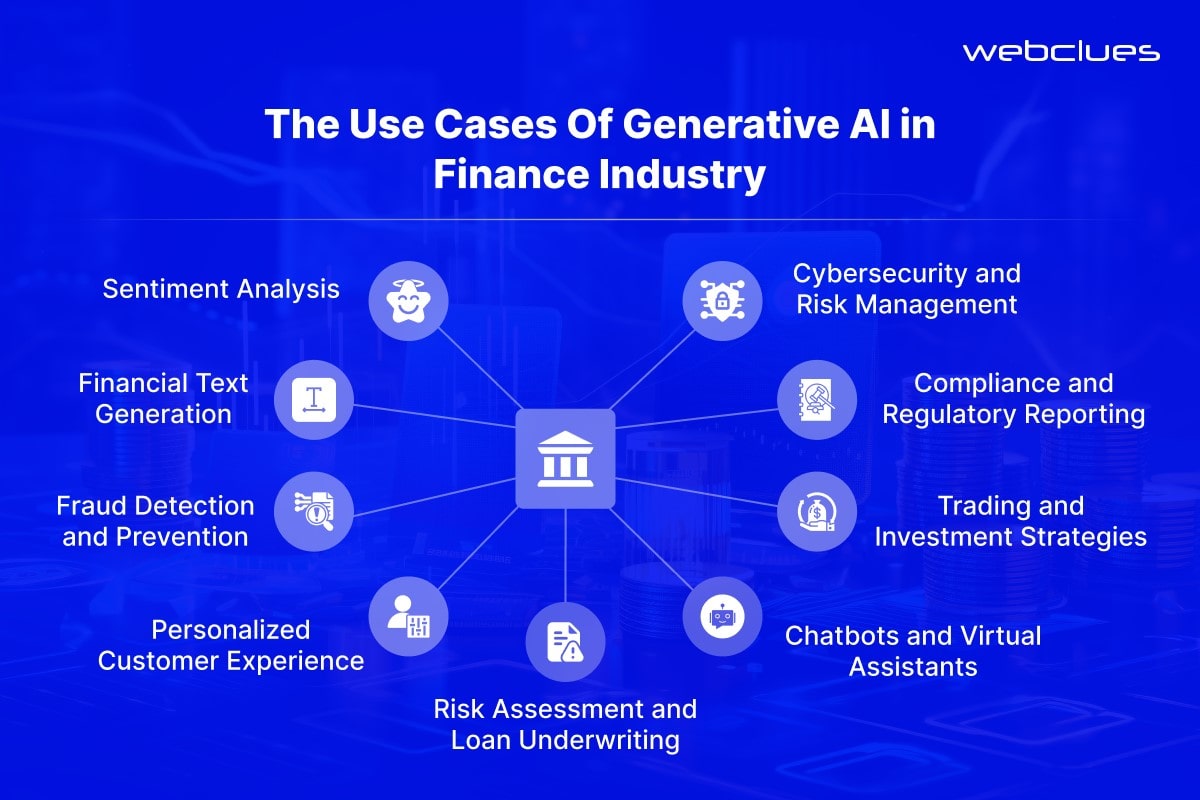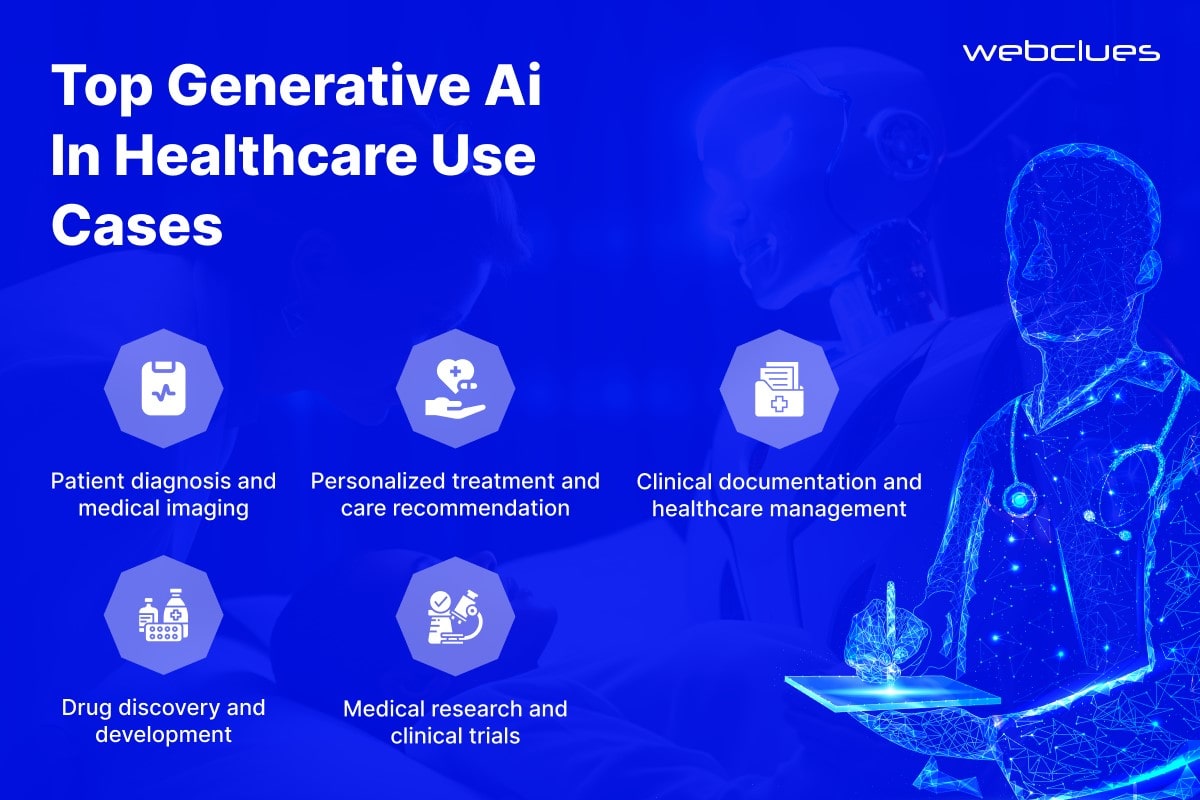A Comprehensive Guide to Generative AI Applications & Industry Use Cases
.png)
What happens when artificial intelligence (AI) goes beyond just analyzing data but rather creates something brand new using that data? Enter Generative AI. In case you’re wondering and looking for a simpler answer to the question of what is Generative AI, it is a branch of artificial intelligence that focuses on utilizing organized or unorganized data and creating new and realistic content, whether it's images, text, videos, code, or even music.
Generative AI goes beyond the usual AI assistants and chatbots, pushing the boundaries of what machines can do and holding immense significance across diverse industries. From generating realistic medical images for diagnosis to personalizing marketing campaigns with unique content, generative AI applications are vast and varied.
But how does this “creativity switch” work? Let’s find out!
Under the Hood: How Generative AI Works
Essentially, instead of analyzing data, Generative AI learns from it. It devours massive amounts of information, like music samples or fashion trends, and then uses that knowledge to create something brand new. Generative AI operates on complex algorithms that allow it to learn from existing data and generate new content autonomously. Some of the most prominent techniques include generative adversarial networks (GANs), variational autoencoders (VAEs), and transformers.
GANs comprise two neural networks - the generator and the discriminator - that work in tandem. The generator creates new content, such as images or text, while the discriminator evaluates the generated content against real examples. Through continuous feedback and iteration, the generator learns to produce increasingly realistic output.
VAEs, on the other hand, learn to encode and decode data, allowing them to generate new content by sampling from the learned data distribution.
Now that you have a basic understanding of what generative AI is and how it works, let’s explore some of the top applications and use cases of this technology in various domains and industries.
Top Applications of Generative AI
The capabilities of Generative AI are boundless. From generating lifelike images to composing music and crafting compelling narratives, Generative AI development companies are revolutionizing industries across the board. Let’s explore how these capabilities translate to some of the most pragmatic applications.

Image Generation and Enhancement
The emergence of Generative AI tools is bringing about a significant shift in image content creation. These tools offer exciting possibilities for both professionals and casual users, allowing them to generate entirely new images or enhance existing ones with remarkable accuracy and flexibility.
For instance, text-to-image tools like DALL-E 2 and Midjourney utilize deep learning algorithms to understand your textual descriptions – be it a product mockup, a historical scene, or an abstract composition - and translate them into high-quality, photorealistic images. You can specify details such as style, setting, and objects, granting you granular control over the final output.
The capabilities of Generative AI extend beyond generating new images. Powerful enhancement tools offer a versatile suite of functionalities to manipulate and improve existing photos. Whether you seek to:
- Fill in missing elements: Generative AI tools can effortlessly complete incomplete images, be it generating a realistic background for a portrait, filling in missing pixels, or restoring damaged photographs.
- Transform sketches into photorealistic masterpieces: You can breathe life into your artistic creations by utilizing tools like Imagen and GauGAN2 to convert simple sketches into breathtaking, photorealistic images.
- Modify existing visuals: Generative AI can help you adjust the style, lighting, color, or form of existing images while preserving their original content. This allows for versatile experimentation and the creation of entirely new visual interpretations.
- Sharpen and refine: One can even enhance the resolution of an image without compromising its details, which is particularly useful for improving the quality of low-resolution images or those captured with outdated cameras.
However, beyond these incredible applications, it's crucial to address the ethical considerations and potential misuse of this powerful technology. Deepfakes and manipulated images can have serious consequences. It's essential to use AI-generated visuals responsibly, transparently, and with respect for copyright and authenticity.
Video Generation
Generative AI is reinventing video creation, taking visual storytelling to a whole new level. It offers a powerful suite of tools that optimize workflows, enhance efficiency, and open up creative possibilities. By automating tedious tasks like video composition, special effects integration, and animation, AI aids creators and businesses in producing high-quality content at an unprecedented pace.
Similar to its impact on image creation, Generative AI can generate videos entirely from scratch. All you need to do is provide a text description or reference materials, and AI algorithms will create your desired video – whether it is a captivating explainer, a product demo with stunning visuals, or a social media ad with engaging animation. Not only that, you can even customize the video to your specifications, saving you valuable time and resources.
Generative AI also offers robust tools for manipulating and enhancing existing content. You can utilize generative AI to upscale a low-quality video without sacrificing detail or generate realistic replacements for blurry sections and missing, ensuring smooth and complete video experiences.
Beyond these core functionalities, cutting-edge generative AI algorithms offer even more advanced possibilities:
- Video Prediction: Employing generative models to predict future frames in a video, enabling realistic object and character motion, and enhancing the overall naturalness of the visual narrative.
- Video style transfer: Applying the stylistic elements of another video or reference image to a new video, offering creative control and unique storytelling opportunities.
Audio Generation
A Generative AI agency utilizes advanced algorithms to create and manipulate audio content with unprecedented accuracy and realism, redefining the way we interact with sound. It goes beyond mere automation, offering unprecedented flexibility and efficiency in creating high-quality audio content across various industries.
There are several prominent applications of generative AI in audio generation:
Music Composition: One of the primary applications of Generative AI in audio generation is the creation of music. Through sophisticated machine learning models, Generative AI can compose original musical pieces, mimicking various styles and genres with remarkable fidelity. This capability has transformed the music industry, helping artists and composers explore new creative avenues and produce captivating compositions.
Text-to-Speech (TTS) Generators: Specific generative AI tools convert written text into spoken words with natural-sounding voices, supporting applications such as virtual assistants, audiobooks, and accessibility tools for individuals with disabilities. Generative AI-driven TTS generators have significantly improved the accessibility and usability of digital content, making information more accessible to a broader audience.
Speech-to-Speech (STS) Conversion: Breaking down language barriers becomes effortless with AI-powered STS solutions. The technology facilitates real-time translation and modification of spoken language, making communication feasible across language barriers and improving the accessibility of audio content in multilingual contexts. STS conversion has diverse applications, ranging from language learning platforms to voice-enabled translation services, transforming the way we communicate and interact globally.
Popular Tools:
- Amper Music
- Jukebox
- Murf
- Resemble.ai
- DeepL
- Revoice
Industry Applications:
- Entertainment: Personalized soundtracks for films, trailers, and games.
- Marketing & Advertising: Engaging voiceovers for commercials and explainer videos.
- E-learning & Education: Immersive audio content for learning modules and simulations.
- Accessibility: Text-to-speech solutions for individuals with visual impairments.
- Customer Service: Real-time translation for multilingual customer interactions.
Text Generation and Summarization
Generative AI tools like ChatGPT have brought about a revolution in the field of text generation and manipulation. They offer unmatched efficiency and flexibility in crafting content, summarizing information, and translating languages.
Natural Language Processing (NLP) and Natural Language Understanding (NLU) are at the core of this technology. These AI techniques allow systems to read text prompts, comprehend context and intent, and generate intelligent responses. Trained on vast data sets, these systems produce authentic and up-to-date content, from compelling blog posts to informative summaries.
Generative AI tackles a diverse range of language-related tasks with remarkable efficiency. This includes:
- Answering questions: Providing insightful responses to complex queries, making information readily accessible.
- Text completion: Flawlessly filling in missing segments of text, ensuring content coherence and flow.
- Text classification: Categorizing text data according to specific criteria, facilitating efficient organization and analysis.
- Content improvement: Rephrasing and enhancing existing content for clarity, conciseness, and effectiveness.
- Human-like conversations: Engaging in natural and informative dialogues on various topics, powering chatbots and virtual assistants.
Industry-Specific Applications:
This spectrum of capabilities translates into impactful applications across various industries:
- Creative writing: Unleashing creative expression by generating story elements, song lyrics, or poems, sparking imaginative exploration.
- Conversational agents: Developing virtual assistants and chatbots that provide instant customer support, answer questions, and enhance user experience.
- Translation: Breaking down language barriers with swift and accurate translation of text, fostering global communication and understanding.
- Marketing and advertising: Generating engaging marketing materials like product descriptions, ad copy, and social media content, captivating audiences and driving engagement.
Software and Coding
Advanced Generative AI models possess the incredible ability to generate code snippets, automate repetitive tasks, and assist in various stages of the design and development processes. This translates to increased efficiency, reduced development time, and ultimately, more innovative software solutions.
The key capabilities of generative AI in software development and coding include:
Code Completion: Powerful generative AI models can analyze the context of the code and suggest the next line of code, optimizing the development process and reducing manual effort. This feature significantly boosts developer productivity by providing intelligent suggestions customized to the specific coding context.
Code Generation: AI models excel in code generation, harnessing their natural language processing capabilities to convert textual prompts into functional code. This allows developers to express their ideas in natural language and translate them into executable code, accelerating the software development cycle.
Testing and Debugging: Generative AI isn't just about writing code; it also plays a crucial role in ensuring its quality and functionality. Advanced models can generate comprehensive test cases, helping developers identify potential issues before deployment. Additionally, some models can even automatically suggest bug fixes, optimizing the debugging process and reducing the time spent troubleshooting.
Design and Integration Support: Generative AI can even assist in software design, recommending optimal architectures and suggesting efficient solutions based on specific requirements. Furthermore, they can facilitate the integration of machine learning models into software applications, facilitating advanced functionalities such as neural networks or decision models.
Challenges and Limitations:
While Generative AI development services offer immense potential, it's crucial to acknowledge its limitations. Complex coding tasks requiring deep understanding and logic beyond pattern recognition may still demand human expertise. Additionally, ethical considerations surround the use of AI-generated code, emphasizing the need for transparency and responsible implementation.
It is essential to note generative AI is not here to replace developers but to assist them. By utilizing this technology responsibly, it becomes possible for developers to focus on creative problem-solving while AI handles the repetitive tasks. This collaborative approach has the potential to accelerate software development, improve quality, and boost innovation.
Data Augmentation
One of the most impactful applications of generative AI lies in its ability to generate synthetic data, a groundbreaker in AI training. This technology holds the key to overcoming data scarcity issues and boosting the performance of AI models across various applications.
Utilizing powerful models like Generative Adversarial Networks (GANs) and Variational Autoencoders (VAEs), Generative AI can mimic the characteristics of real data, creating vast quantities of synthetic data. This data holds immense value for several reasons:
- Augmenting Training Data: Expanding existing datasets allows for more robust training, leading to higher-performing and more generalizable AI models.
- Testing and Validation: Simulating diverse scenarios through synthetic data paves the way for comprehensive testing and validation. This ensures model preparedness for real-world applications.
- Privacy-Preserving Data Sharing: Sensitive data can be masked or anonymized using synthetic counterparts, facilitating collaboration and research while protecting privacy.
Generative AI captures complex dependencies and statistical properties within real data. However, it's crucial to acknowledge certain limitations. Synthetic data may not always fully replicate the intricate nuances and diversities of real-world scenarios.
Furthermore, careful evaluation of synthetic data quality and fidelity is essential to ensure its usefulness and prevent potential biases or misinterpretations. This, in addition to domain expertise, appropriate training data selection, and rigorous evaluation metrics, is vital for maximizing the reliability and effectiveness of synthetic data generated by Generative AI models.
Organizational Collaboration
The modern workplace demands a dynamic and collaborative environment. Generative AI rises to the challenge, facilitating collaboration and boosting team effectiveness. For instance, generative AI can suggest diverse ideas and concepts and even provide creative prompts to stimulate out-of-the-box thinking. This allows teams to break free from conventional methods, explore new possibilities, and arrive at innovative solutions collaboratively.
Moreover, generative AI can integrate into daily workflows, automating repetitive tasks like scheduling meetings, drafting emails, and generating reports. This frees up valuable time for employees to focus on higher-level strategic thinking and creative problem-solving.
Essentially, by sparking creative thought, facilitating communication, and ensuring everyone is on the same page, this technology can strengthen team dynamics and collaboration. Openness to new ideas, improved communication, and increased individual contributions can lead to a more positive and productive team culture.
Chatbot Performance Improvement
Chatbots have become ubiquitous when it comes to customer service and communication across industries. However, their effectiveness often hinges on their ability to deliver engaging, human-like interactions. This is where Generative AI steps in, as it offers a powerful toolkit to boost chatbot performance.
One of the most significant contributions of Generative AI lies in its ability to generate dynamic and engaging responses, overcoming the limitations of scripted dialogue. By understanding the context and intent behind user queries, these AI models can respond in a more natural and personalized way. This leads to a more genuine and engaging user experience.
Generative AI doesn't just improve conversation flow; it allows for individualized interactions. By analyzing user data and preferences, these models can deliver responses to specific needs and contexts, thus creating a more personalized and relevant experience for each user. This personalized approach enhances trust and satisfaction, leading to more positive interactions and improved brand perception.
Enterprise Search
The ever-growing volume of information within organizations can be overwhelming, hindering efficient information retrieval and informed decision-making. Fortunately, generative AI can address this daunting issue, reinventing knowledge accessibility and understanding.
Enterprise search often relies on keyword matching, leading to irrelevant results and frustration. Generative AI takes a sophisticated approach, understanding the user's intent behind the search query. This allows for more precise results, surfacing the most relevant documents and information, saving time and effort.
Sifting through countless documents to find specific information can be time-consuming. Generative AI models can automatically generate summaries of relevant documents, highlighting key points and extracting crucial information. This allows users to quickly grasp the essence of the content and make informed decisions faster.
Furthermore, by understanding the context and relationships within documents, Generative AI can uncover hidden patterns and insights that might otherwise go unnoticed. This provides decision-makers with a deeper understanding of the information at hand, leading to more informed and strategic choices.
Industry-wise Use Cases of Generative AI
The array of generative AI applications being pretty wide, the technology is rapidly weaving its way into the fabric of various industries. It’s revolutionizing these industries by injecting creative problem-solving and data-driven insights. Let’s explore how generative AI is finding impactful use cases in different sectors.
Finance
- Fraud Detection: AI models analyze vast amounts of financial data to identify suspicious patterns and prevent fraudulent transactions. This safeguards financial institutions and consumers.
- Personalized Financial Products: Customized investment recommendations, risk assessments, and insurance plans are generated based on individual needs and financial goals, improving financial well-being.
- Market Analysis: AI-powered algorithms analyze market trends, predict future movements, and generate insightful reports. This helps individuals make informed investment decisions.

Manufacturing
- Design Optimization: Generative AI designs products with optimal performance and efficiency, considering factors like material properties, manufacturing constraints, and cost.
- Personalized Product Recommendations: AI algorithms utilize customer data and preferences to suggest relevant products, enhancing customer satisfaction and driving sales.
- Predictive Maintenance: AI models analyze sensor data to predict equipment failures before they occur. This prevents costly downtime and ensures smooth operations.
Medical & Healthcare
- Drug Discovery: AI-powered simulations accelerate the process of drug discovery by identifying potential molecules with desired properties, leading to faster development of new treatments.
- Personalized Medicine: AI analyzes genetic and medical data to devise treatment plans and drug dosages for individual patients, thus optimizing healthcare outcomes.
- Medical Imaging Analysis: AI models analyze medical images with high accuracy. This helps doctors diagnose diseases and make informed treatment decisions.

Law Firms
- Legal Document Generation: AI generates routine legal documents like contracts and agreements, saving lawyers time and resources.
- Contract Review: AI highlights potential risks and inconsistencies in legal documents to ensure accuracy and compliance.
- Legal Research Assistance: AI-powered tools efficiently search through legal databases and provide relevant case law and precedents to aid research processes.
Entertainment
- Personalized Content Creation: AI generates personalized music playlists, movie recommendations, and even writes stories based on individual preferences.
- Movie Special Effects: AI creates realistic and complex visual effects for movies and games, pushing the boundaries of creative storytelling.
- Virtual Reality Experiences: AI-powered VR experiences offer immersive and interactive environments for entertainment, education, and training.
Real Estate
- Virtual Property Tours: AI generates realistic virtual tours of properties, allowing potential buyers to explore remotely and shortlist options efficiently.
- Personalized Property Recommendations: AI suggests properties that align with individual needs and budgets, optimizing the search process.
- Market Trend Analysis: AI models analyze market data to predict future trends and prices to aid informed investment decisions in real estate.
Education and Training
- Personalized Learning Experiences: AI adapts learning materials and pace to individual student needs and learning styles. This further improves engagement and knowledge retention.
- Adaptive Learning Platforms: AI-powered platforms personalize learning pathways based on student performance, thereby providing targeted support and ensuring mastery of concepts.
- Generating Educational Content: AI generates personalized quizzes, practice exercises, and even educational videos. This leads to a significant increase in student engagement and learning outcomes.
Retail & E-Commerce

- Personalized Product Recommendations: AI suggests relevant products to each customer based on their browsing history and purchase patterns, driving sales and customer satisfaction.
- Chatbots for Customer Service: AI-powered chatbots answer customer questions, resolve issues, and personalize interactions, offering 24/7 support and convenience.
- Targeted Marketing Campaigns: AI analyzes customer data to create personalized marketing campaigns with high engagement and conversion rates.
A Glimpse into the Future
The revolution called generative AI has just begun. As we witnessed its transformative impact across industries, it's crucial to consider the exciting possibilities that lie ahead, alongside the challenges that need to be addressed.
A symbiotic collaboration is on the horizon, as the lines between human and AI expertise will continue to blur. We can expect a future where humans leverage generative AI's creative and analytical power, while simultaneously guiding its development and maneuvering ethical implementation. Plus, with the improving democratization of AI, access to and affordability of generative AI tools will increase. This will allow individuals and smaller organizations to benefit from its capabilities, fueling innovation across diverse sectors.
As Generative AI models become more complex, understanding their decision-making processes will become crucial. Continued research in explainable AI will be vital to ensure trust and responsible use. Moreover, addressing potential biases, ensuring data privacy, and mitigating the risk of misuse will be ongoing challenges requiring collaboration between technologists, policymakers, and the public.
Essentially, the future of Generative AI is brimming with potential, but it's a shared responsibility to ensure its development and application benefit humanity. Tracing the path ahead with collaboration, transparency, and ethical considerations, we can harness the power of generative AI to build a more innovative, inclusive, and sustainable future.
Build Your Agile Team
Hire Skilled Developer From Us
Future-proof your business with cutting-edge AI integration
The applications of generative AI span across industries and integrating the technology into your business processes can help you stay ahead of the competition. Connect for a free consultation today!
Book a Call!Our Recent Blogs
Sharing knowledge helps us grow, stay motivated and stay on-track with frontier technological and design concepts. Developers and business innovators, customers and employees - our events are all about you.
Contact
Information
India
Ahmedabad
1007-1010, Signature-1,
S.G.Highway, Makarba,
Ahmedabad, Gujarat - 380051
Rajkot
1308 - The Spire, 150 Feet Ring Rd,
Manharpura 1, Madhapar,
Rajkot, Gujarat - 360007
UAE
Dubai
Dubai Silicon Oasis, DDP,
Building A1, Dubai, UAE
USA
Atlanta
6851 Roswell Rd 2nd Floor,
Atlanta, GA, USA 30328
New Jersey
513 Baldwin Ave, Jersey City,
NJ 07306, USA
California
4701 Patrick Henry Dr. Building
26 Santa Clara, California 95054
Australia
Queensland
120 Highgate Street,
Coopers Plains,
Brisbane, Queensland 4108
UK
London
85 Great Portland Street, First
Floor, London, W1W 7LT
Canada
Burlington
5096 South Service Rd,
ON Burlington, L7l 4X4
Let’s Transform Your Idea into
Reality. Get in Touch





